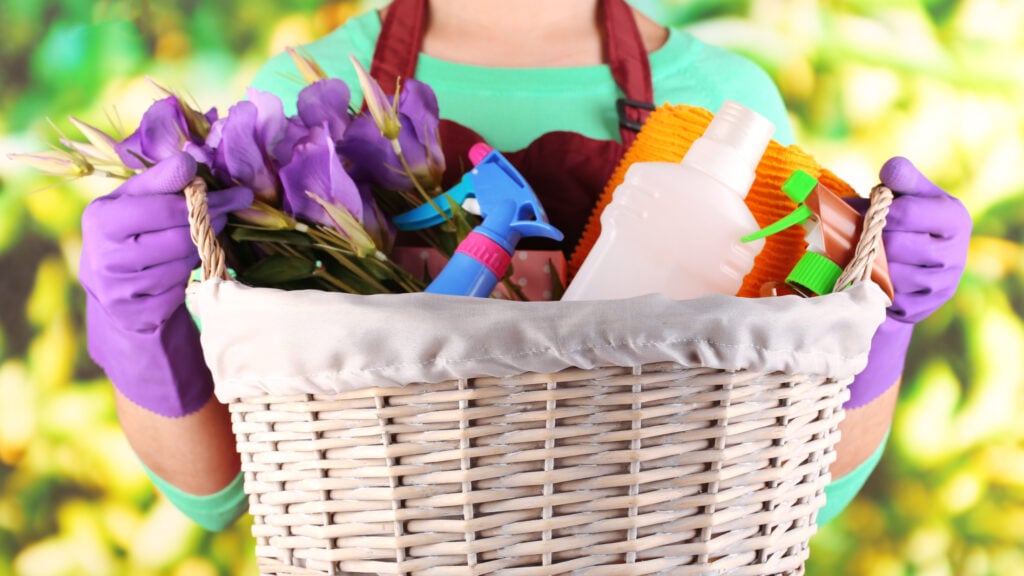
Why do we spring clean?
Sarah Harley
Make time in the kitchen feel more of a pleasure and less of a mess.
For many families, the kitchen feels like the emotional heart of the home – the place for conversation, cooking together or evenings spent pouring hearts out around the table with a couple of glasses to hand.
However, with all the activity comes a lot of clutter and accumulated dirt, so we can end up spending an enormous amount of time cleaning in there.
 Credit: Shutterstock/Evgeny Atamaneko
Credit: Shutterstock/Evgeny AtamanekoFor many families, the kitchen feels like the emotional heart of the home – the place for conversation, cooking together or evenings spent pouring hearts out around the table with a couple of glasses to hand.
However, with all the activity comes a lot of clutter and accumulated dirt, so we can end up spending an enormous amount of time cleaning in there.
 Credit: Shutterstock/Evgeny Atamaneko
Credit: Shutterstock/Evgeny AtamanekoAccording to research commissioned by kitchen manufacturer Howdens, the average adult predicts they do 300 steps a day in the kitchen alone, and 41% of the 2,000 adults questioned say it’s still the room where they spend the most time.
Sue Spencer, professional organiser, highly recommends the benefits of ‘another room basket’. At the end of every day, take a look around the kitchen for anything that doesn’t belong there, as the hub of the home can easily become the catch all place for items on their way somewhere.
When quickly looking at her own kitchen, Spencer found parcels to be posted, letters and suntan lotion. Having a basket to hand allows you to sweep the rogue items you find at the end of each day and redistribute them to their correct homes.
 Credit: Shutterstock/Kostikova Natalia
Credit: Shutterstock/Kostikova NataliaIf time is not an issue, some of us automatically do this without even thinking. But have you thought about what you could achieve while just waiting for the kettle to boil or the oven timer to ping?
Simply wiping down a few cupboard doors or picking the inside of one cupboard to declutter can make it far easier to stay on top of the bigger weekly clean.
Even dried or tinned goods, which you would imagine to be clean, can benefit from being placed in a storage container.
Why not decant dried items such as pasta or pulses into stylish glass mason jars, or simply pop tins into a clear plastic basket so you can easily take them in and out of cupboards to clean?
One basket to move compared to five individual jars is always going to be easier to deal with and the process of reorganising will allow you to check sell-by-dates and remove anything no longer edible.
John Lewis stocks a good range of kitchen storage including these clear baskets and mason jars.
 Credit: John Lewis
Credit: John LewisThe same applies for items in the fridge – opening the door to a fridge where items are contained in storage trays makes it far easier to keep on top of drips and spills. Companies such as A Place for Everything are a great place to start your new storage collection.
We spoke to expert cleaning company, Merry Maids to find out if there was any swift way to deal with the grime-trap that is our ovens, with the company keen to impress upon us the time-saving value of liners and trays.
These simple products can be placed not just inside the oven to stop things getting messy so quickly, but all around the kitchen.
They also won’t add much – if any – clutter to the inside of your culinary storage spots and can save loads of time when it comes to spills or errant food.
 Credit: Lakeland
Credit: LakelandLining ideas
In the case of kitchen bins, too often we make the mistake of buying small so that it can be hidden away out of sight. This may work if you have more than one hiding space for different types of waste, or if you had a kitchen designed with several integrated bins.
If not, then embrace the waste. Designers have recognised that customers need not only a functional but also an aesthetically pleasing bin .
If asked to recommend one company that manages to make even waste look stylish, I’d always answer Joseph Joseph. Although the brand may err towards the premium price bracket, its sleek, minimalistic, cleverly designed products have both form and function.
This 40L combi waste and recycling bin gives you three separate compartments for food, recycling and general waste. With its tall stacking design and inbuilt odour control, it would sit comfortably against a wall or at the side of kitchen units. It’s a great solution when space is at a premium.
 Credit: Joseph Joseph
Credit: Joseph JosephIf you find yourself faced with overflowing shelves of crockery, cookware, utensils and a plethora of mugs every time you open a cupboard or drawer – a sight which is enough to put anyone off cleaning – put aside some time to sort and discard.
Clear some space and empty all the cupboards and drawers in one go. Place each item into a sub-category such as mugs, roasting trays and saucepans and it will suddenly become easier to see quite how many of each item you have.
Be realistic about which ones you never use and if they are still usable, donate them to a charity shop. Someone else’s unwanted goods are often someone else’s treasure.
 Credit: Shutterstock/Kostikova Natalia
Credit: Shutterstock/Kostikova NataliaIf you’ve decided that however much spring cleaning and organising you do, what you really need is a new kitchen, we’ve called in an expert for some more advice.
Marissa Woodley, Category Lead for Fitted Kitchens at John Lewis, shared with us the top five areas you need to consider if your end goal is an easy-to-clean kitchen.
 Credit: John Lewis
Credit: John LewisMake sure you create enough storage space to not only help reduce clutter and dust, but to also keep your worksurfaces clear for easy cleaning.
If you want an open-shelved look but would rather avoid regular dusting, consider glass-fronted units.
 Credit: Victoria Plumbing
Credit: Victoria PlumbingSome appliances will naturally be easier to clean than others. For example, induction hobs are perfectly flat – meaning they’re easier to wipe down than traditional hobs.
Similarly, opting for an inset sink – sitting underneath the edges of your worktop – can make for easy cleaning, as you can wipe worksurfaces straight into the basin. Belfast sinks are a good example of this.
 Credit: John Lewis
Credit: John LewisChoosing the right worktop can make a big difference, as some materials will be more resistant to stains and scratches.
Ceramica, Corian and solid surface worktops are particularly popular choices – but laminates can also be hardwearing, without the price tag.
 Credit: Fired Earth
Credit: Fired EarthTiled surfaces are quick and easy to clean and make a great splashback. If you do opt for tiles, consider what colour grout you want to use.
Darker colours can hide stains – but also provide a really striking look if used with lighter tiles.
 Credit: John Lewis
Credit: John LewisThe humble kitchen tap might not seem like a focus, but there are lots of options which can help clean your kitchen. For example, some have a pull-out spout, so you can aim water around the sink. Others can offer instant boiling water, so you needn’t have a kettle on the worktop which helps to reduce clutter.

Written by Sarah Harley she/her
Published: Updated:
Since first picking up a paintbrush and experiencing the joy of re-decorating her bedroom in a questionable red, white and grey scheme as a young teenager, Sarah Harley was hooked on the world of interior design. This obsession even led to a real life ‘Grand Designs’ project in 2005 when she donned a pink hard hat and appeared on TV screens, project managing the renovation and extension of a Grade II listed 17th century Folly in South Wales.
Throughout her career, Sarah has gained an array of experience in several different roles, ranging from copywriting, PR, events management and photography to interior design and home staging. With her two passions being the written word and the joys of a beautifully designed home, Sarah’s mission is to open the door on the world of interiors, inviting readers in to help them work their way through the vast choice of products, ideas and trends so that their own homes can reach their full potential.